Megafires in a Warming World: What Wildfire Risk Factors Led to California’s Largest Recorded Wildfire
Abstract
:1. Introduction
2. Materials and Methods
2.1. Case Study
2.2. Fire Model
2.3. Meteorological Inputs
2.4. Topography and Fuel Inputs
2.5. Model Calibration
2.6. Experimental Design
2.6.1. Sensitivity to Climate
2.6.2. Sensitivity to FMC
2.6.3. Sensitivity to Heatwaves
3. Results
3.1. Control Run Simulation
- Very high load, dry climate shrub (SH7)—18,676 ha;
- Very high load, dry climate timber-shrub (TU5)—15,244 ha;
- Long-needle litter (TL8)—8095 ha;
- Moderate load, dry climate grass-shrub (GS2)—3752 ha.
3.2. Sensitivity to Climate
3.3. Sensitivity to FMC
3.4. Sensitivity to Heatwaves
3.5. Model Sensitivity to Temperature/VPD
4. Discussion and Conclusions
Author Contributions
Funding
Data Availability Statement
Acknowledgments
Conflicts of Interest
Appendix A
| Abbreviation | Description |
|---|---|
| DC | Drought code |
| DEM | Digital elevation model |
| DMC | Duff moisture code |
| ECMWF | European Centre for Medium-Range Weather Forecasts |
| ERA5 | ECMWF reanalysis 5th generation |
| FBP | Canadian Forest Fire Behavior Prediction |
| FFMC | Fine fuel moisture code |
| FMC | Fuel moisture content |
| FWI | Canadian fire weather index |
| HR | Heat release |
| ISI | Initial spread index |
| LANDFIRE | Landscape Fire and Resource Management Planning Tools |
| PCA | Principal component analysis |
| PDT | Pacific Daylight Time |
| RH | Relative humidity |
| ROS | Rate of spread |
| VIIRS | Visible Infrared Imaging Radiometer Suite |
| VPD | Vapor pressure deficit |
| WRF | Weather Research and Forecasting |
| WS | Wind speed |
| Grid Value | Descriptive Name | Fuel Type | Grid Value | Descriptive Name | Fuel Type |
|---|---|---|---|---|---|
| 91 | NB1 | Non-fuel | 146 | SH6 | M-1 (50 PC) |
| 92 | NB2 | Non-fuel | 147 | SH7 | M-1 (85 PC) |
| 93 | NB3 | Non-fuel | 148 | SH8 | M-1 (30 PC) |
| 98 | NB8 | Non-fuel | 149 | SH9 | M-1 (80 PC) |
| 99 | NB9 | Non-fuel | 161 | TU1 | D-1 |
| 101 | GR1 | O-1a | 162 | TU2 | M-1 (30 PC) |
| 102 | GR2 | O-1a | 163 | TU3 | M-1 (80 PC) |
| 103 | GR3 | O-1b | 164 | TU4 | M-1 (45 PC) |
| 104 | GR4 | O-1b | 165 | TU5 | M-1 (20 PC) |
| 105 | GR5 | O-1b | 181 | TL1 | C-5 |
| 106 | GR6 | O-1b | 182 | TL2 | D-2 |
| 107 | GR7 | O-1b | 183 | TL3 | C-5 |
| 108 | GR8 | O-1b | 184 | TL4 | D-1 |
| 109 | GR9 | O-1b | 185 | TL5 | M-2 (20 PC) |
| 121 | GS1 | M-1 (35 PC) | 186 | TL6 | M-1 (20 PC) |
| 122 | GS2 | M-1 (70 PC) | 187 | TL7 | M-2 (10 PC) |
| 123 | GS3 | M-1 (60 PC) | 188 | TL8 | M-2 (20 PC) |
| 124 | GS4 | M-1 (50 PC) | 189 | TL9 | M-1 (25 PC) |
| 141 | SH1 | D-1 | 201 | SB1 | S-2 |
| 142 | SH2 | M-1 (25 PC) | 202 | SB2 | S-1 |
| 143 | SH3 | M-1 (10 PC) | 203 | SB3 | S-3 |
| 144 | SH4 | M-1 (75 PC) | 204 | SB4 | S-3 |
| 145 | SH5 | M-1 (95 PC) | 9999 | NoData | M-1 (90 PC) |
| USA | Description and ROS | Canada | Description and ROS |
|---|---|---|---|
| SH7 | Very high load, dry climate shrub, woody shrubs and shrub litter, very heavy shrub load, depth 4–6 feet, flame very high | M-1 (85 PC) | Boreal mixedwood-leafless, moderately well stocked mixed stand of boreal conifers and deciduous species, 85 percent conifer (PC)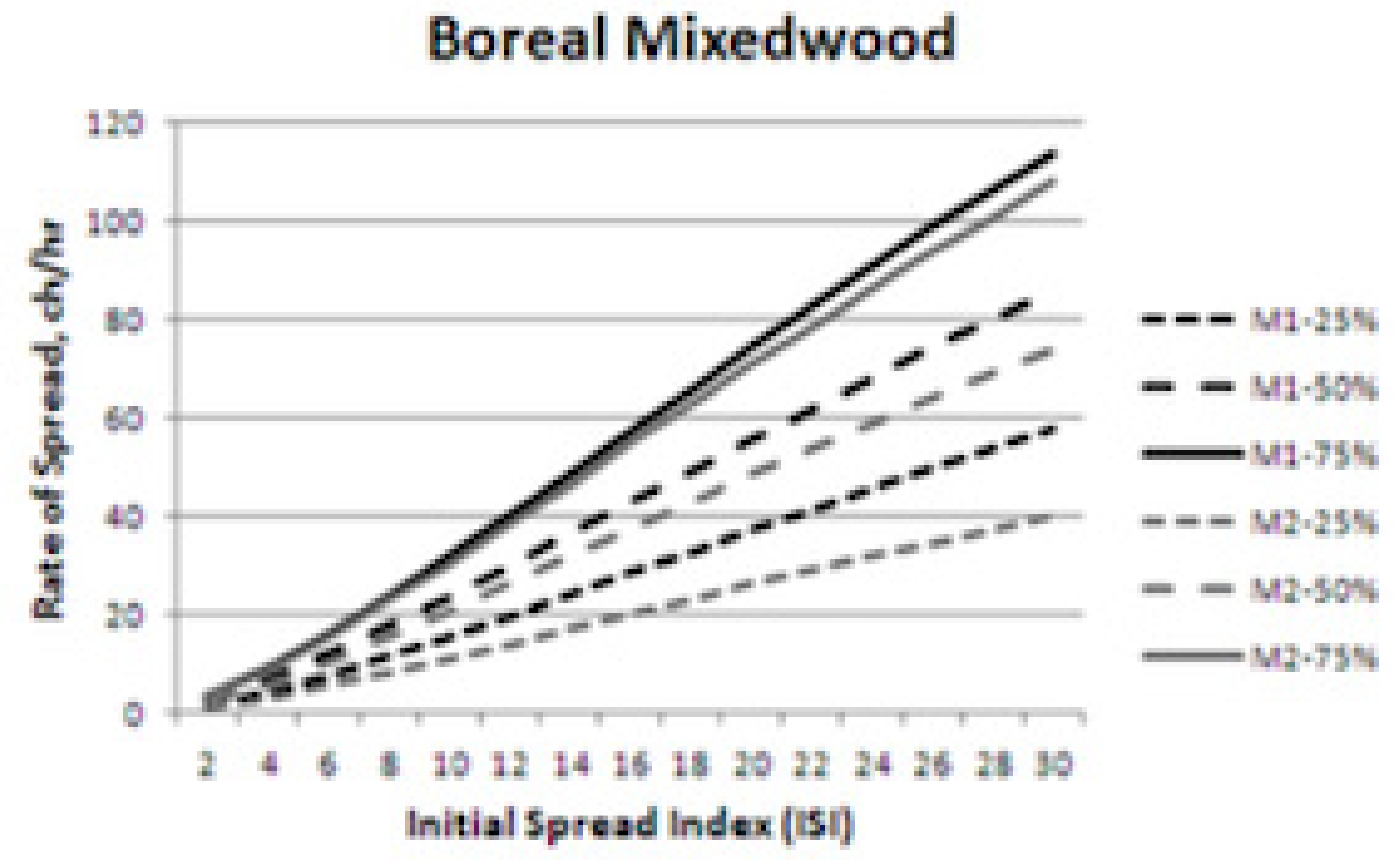 |
| TU5 | Very high load, dry climate shrub, heavy forest litter with shrub or small tree understory, spread rate and flame moderate | M-1 (20 PC) | Boreal mixedwood-leafless, moderately well stocked mixed stand of boreal conifers and deciduous species, 20 percent conifer (PC)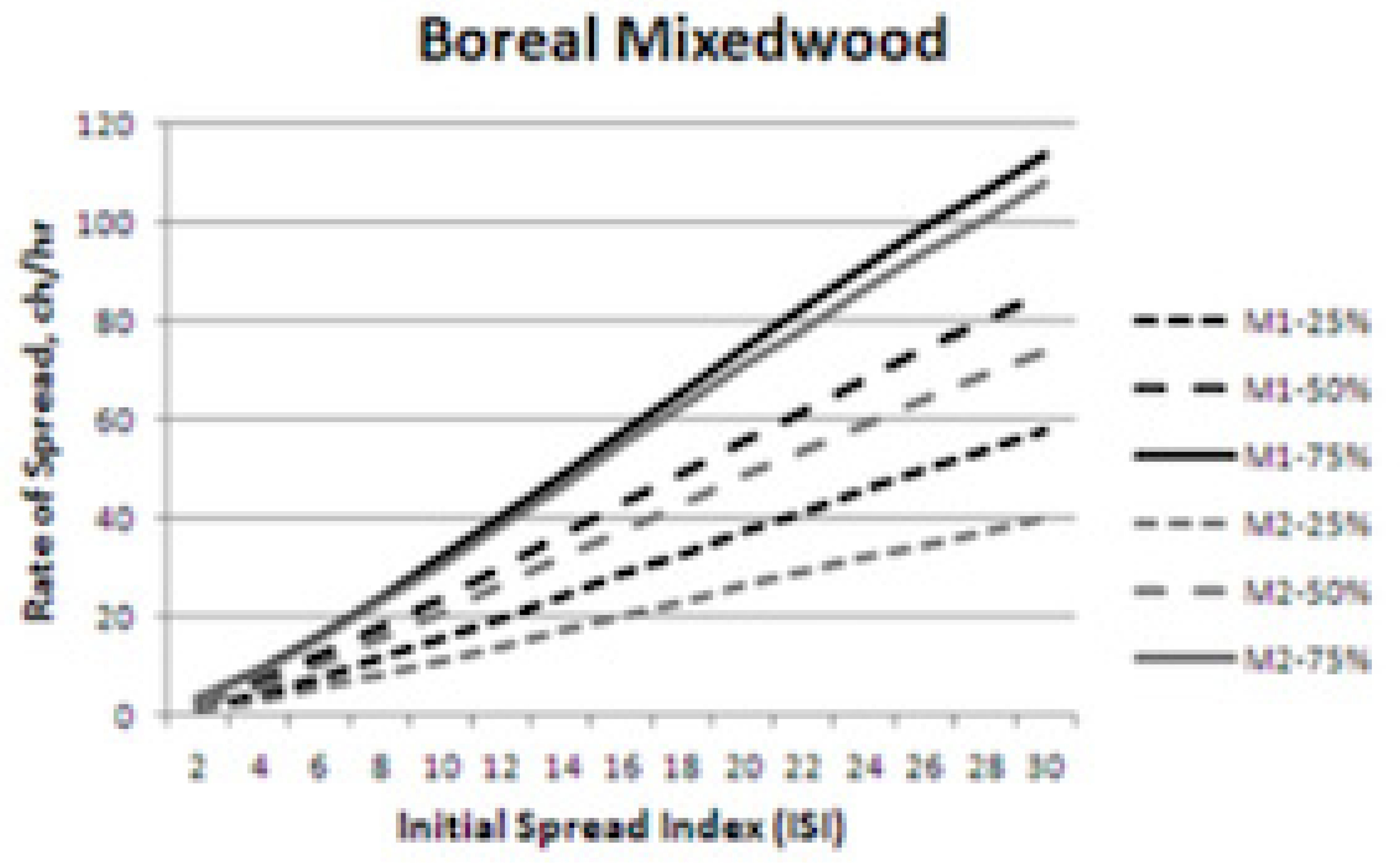 |
| TL8 | Long needle litter, moderate load long needle pine litter, may have small amounts of herbaceous fuel, spread rate moderate and flame low | M-2 (20 PC) | Boreal mixedwood-green, moderately well stocked mixed stand of boreal conifers and deciduous species, 20 percent conifer (PC)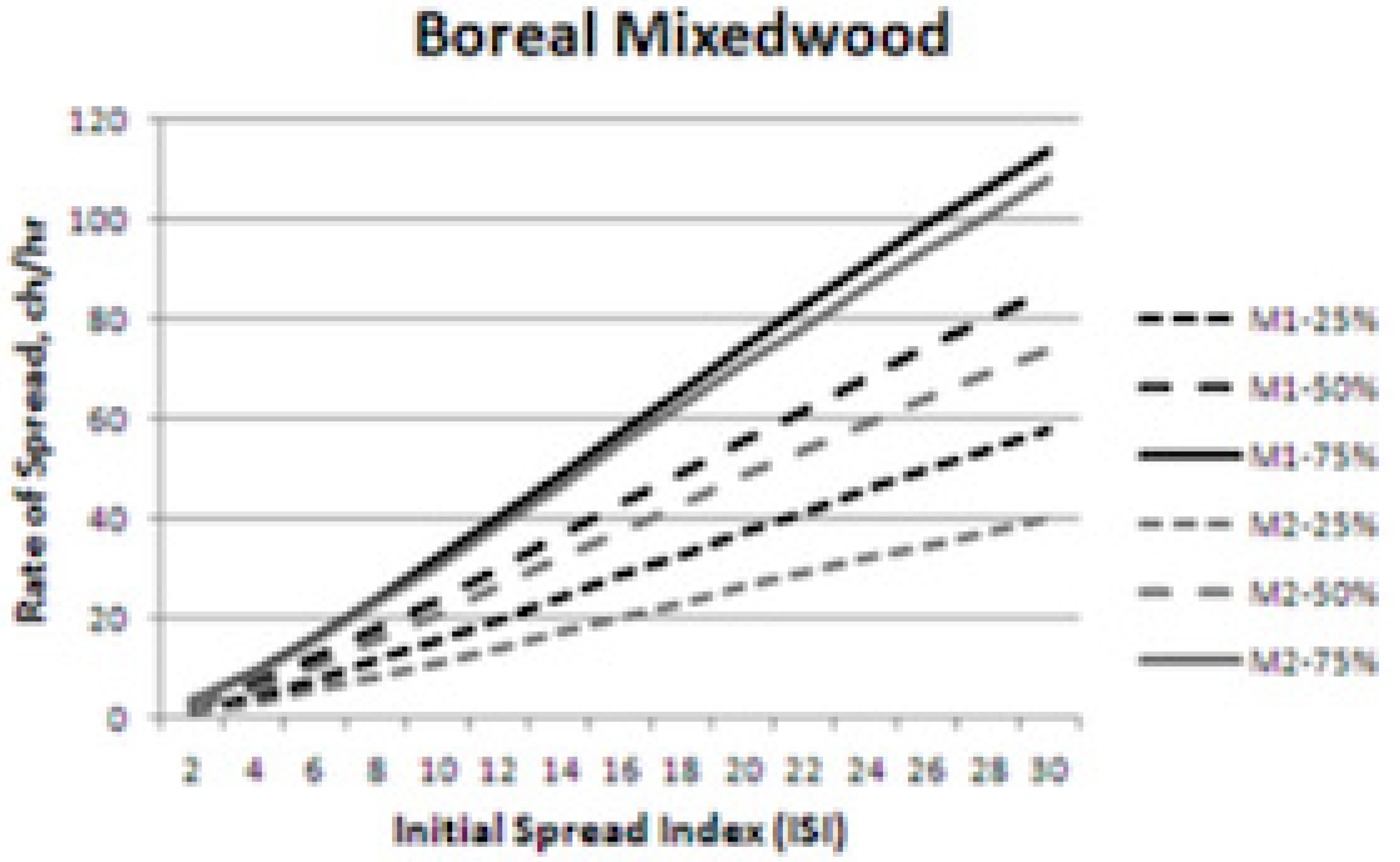 |
| GS2 | Moderate load, dry climate grass-shrub, shrubs are 1-3 feet high, grass load moderate, spread rate high, and flame length is moderate | M-1 (70 PC) | Boreal mixedwood-leafless, moderately well stocked mixed stand of boreal conifers and deciduous species, 70 percent conifer (PC)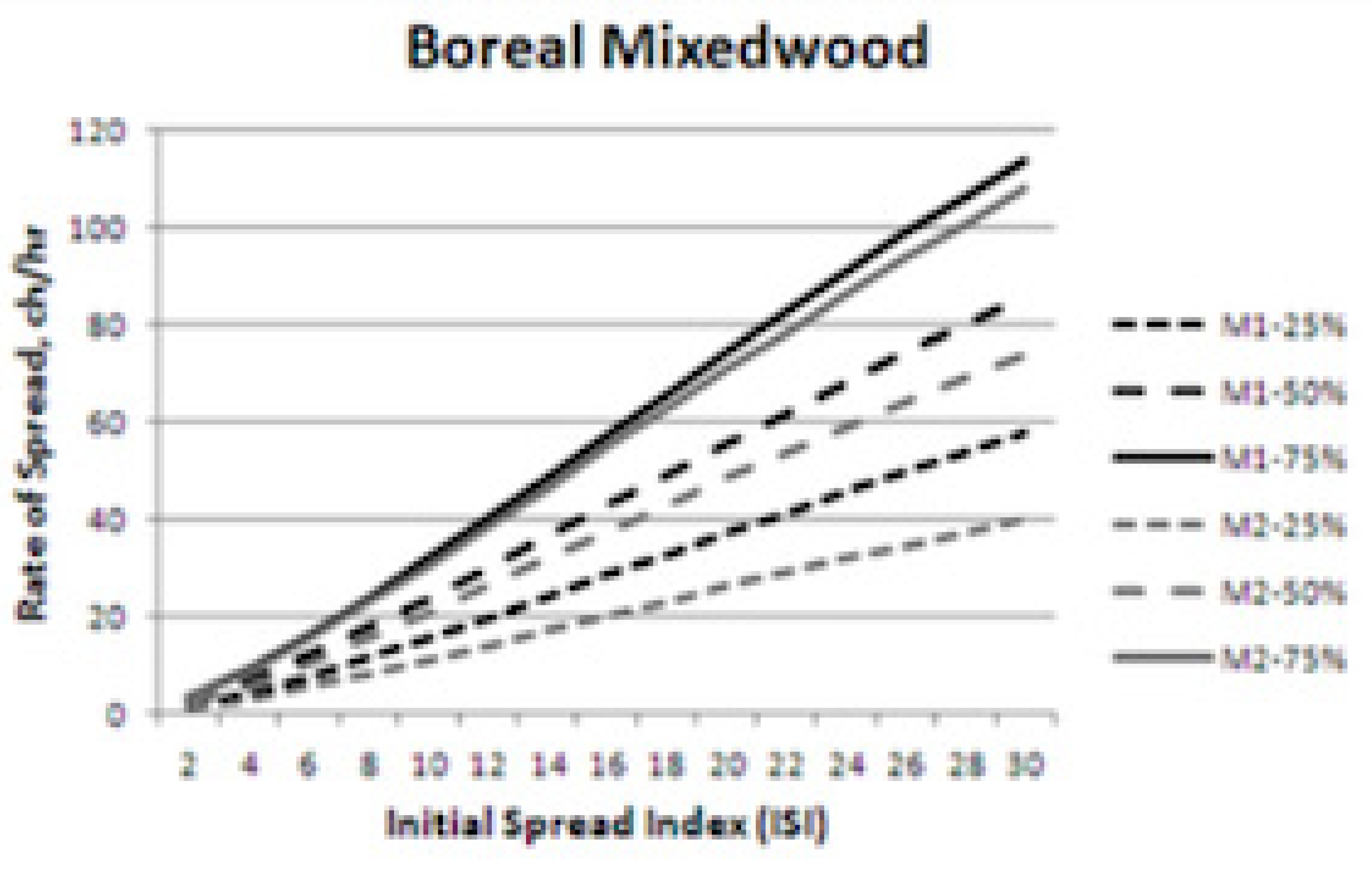 |

References
- Morris, G., III; Dennis, C. The 2020 Fire Siege; California Department of Forestry & Fire Protection: Sacramento, CA, USA, 2020. [Google Scholar]
- NIFC National Interagency Coordination Center. Wildland Fire Summary and Statistics Annual Report 2020. 2020. Available online: https://www.predictiveservices.nifc.gov/intelligence/2020_statssumm/annual_report_2020.pdf (accessed on 5 August 2021).
- California Departement of Water Resources (CA Dept. Water Resources). Water Year 2020 Summary Information. 2020; Volume 2020, pp. 1–4. Available online: https://water.ca.gov/-/media/DWR-Website/Web-Pages/What-We-Do/Drought-Mitigation/Files/Publications-And-Reports/Water-Year-2020-Handout_Final.pdf (accessed on 12 August 2021).
- Sommers, W.T.; Coloff, S.G.; Conard, S.G. Synthesis of Knowledge: Fire History and Climate Change; JFSP Synthesis Reports Paper 19; U.S. Joint Fire Science Program: Boise, ID, USA, 2011. Available online: https://www.firescience.gov/projects/09-2-01-11/project/09-2-01-11_pnw_gtr854.pdf (accessed on 5 January 2022).
- Perry, D.A.; Hessburg, P.F.; Skinner, C.N.; Spies, T.A.; Stephens, S.L.; Taylor, A.H.; Franklin, J.F.; McComb, B.; Riegel, G. The ecology of mixed severity fire regimes in Washington, Oregon, and Northern California. For. Ecol. Manag. 2011, 262, 703–717. [Google Scholar] [CrossRef]
- Parks, S.A.; Holsinger, L.M.; Panunto, M.H.; Jolly, W.M.; Dobrowski, S.Z.; Dillon, G.K. High-severity fire: Evaluating its key drivers and mapping its probability across western US forests. Environ. Res. Lett. 2018, 13, 44037. [Google Scholar] [CrossRef]
- Estes, B.L.; Knapp, E.E.; Skinner, C.N.; Miller, J.D.; Preisler, H.K. Factors influencing fire severity under moderate burning conditions in the Klamath Mountains, northern California, USA. Ecosphere 2017, 8, e01794. [Google Scholar] [CrossRef] [Green Version]
- Higuera, P.E.; Abatzoglou, J.T. Record-setting climate enabled the extraordinary 2020 fire season in the western United States. Glob. Change Biol. 2021, 27, 1–2. [Google Scholar] [CrossRef]
- Goss, M.; Swain, D.L.; Abatzoglou, J.T.; Sarhadi, A.; Kolden, C.A.; Williams, A.P.; Diffenbaugh, N.S. Climate change is increasing the likelihood of extreme autumn wildfire conditions across California. Environ. Res. Lett. 2020, 15, 94016. [Google Scholar] [CrossRef] [Green Version]
- Williams, A.P.; Abatzoglou, J.T.; Gershunov, A.; Guzman-Morales, J.; Bishop, D.A.; Balch, J.K.; Lettenmaier, D.P. Observed Impacts of Anthropogenic Climate Change on Wildfire in California. Earth’s Future 2019, 7, 892–910. [Google Scholar] [CrossRef] [Green Version]
- Ficklin, D.L.; Novick, K.A. Historic and projected changes in vapor pressure deficit suggest a continental-scale drying of the United States atmosphere. J. Geophys. Res. Atmos. 2017, 122, 2061–2079. [Google Scholar] [CrossRef]
- Abatzoglou, J.T.; Williams, A.P. Impact of anthropogenic climate change on wildfire across western US forests. Proc. Natl. Acad. Sci. USA 2016, 113, 11770–11775. [Google Scholar] [CrossRef] [Green Version]
- Westerling, A.L.; Bryant, B.P. Climate change and wildfire in California. Clim. Change 2007, 87, 231–249. [Google Scholar] [CrossRef]
- Keane, R.E. Fuel Moisture. Wildland Fuel Fundamentals and Application, 1st ed.; Springer: Cham, Switzerland, 2015; pp. 71–82. [Google Scholar] [CrossRef]
- Guirguis, K.; Gershunov, A.; Cayan, D.R.; Pierce, D.W. Heat wave probability in the changing climate of the Southwest US. Clim. Dyn. 2018, 50, 3853–3864. [Google Scholar] [CrossRef]
- Hulley, G.C.; Dousset, B.; Kahn, B.H. Rising Trends in Heatwave Metrics across Southern California. Earth’s Future 2020, 8, 1–21. [Google Scholar] [CrossRef]
- Pathak, T.B.; Maskey, M.L.; Dahlberg, J.A.; Kearns, F.; Bali, K.M.; Zaccaria, D. Climate change trends and impacts on California Agriculture: A detailed review. Agronomy 2018, 8, 25. [Google Scholar] [CrossRef] [Green Version]
- Gershunov, A.; Cayan, D.R.; Iacobellis, S.F. The great 2006 heat wave over California and Nevada: Signal of an increasing trend. J. Clim. 2009, 22, 6181–6203. [Google Scholar] [CrossRef] [Green Version]
- Diffenbaugh, N.S.; Swain, D.L.; Touma, D.; Lubchenco, J. Anthropogenic warming has increased drought risk in California. Proc. Natl. Acad. Sci. USA 2015, 112, 3931–3936. [Google Scholar] [CrossRef] [Green Version]
- Luković, J.; Chiang, J.C.H.; Blagojević, D.; Sekulić, A. A Later Onset of the Rainy Season in California. Geophys. Res. Lett. 2021, 48, 1–9. [Google Scholar] [CrossRef]
- Swain, D.L. A Shorter, Sharper Rainy Season Amplifies California Wildfire Risk. Geophys. Res. Lett. 2021, 48, e2021GL092843. [Google Scholar] [CrossRef]
- Tymstra, C. Development and Structure of Prometheus: The Canadian Wildland Fire Growth Simulation Model; NOR-X-417; Canadian Forest Service, Northern Forestry Centre: Ottawa, ON, Canada, 2010; Volume 417, ISBN 9781100146744. [Google Scholar]
- Opperman, T.; Gould, J.; Finney, M.; Tymstra, C. Applying Fire Spread Simulators in New Zealand and Australia: Results from an International Seminar; RMRS-P-41; US Department of Agriculture, Forest Service, Rocky Mountain Research Station: Fort Collins, CO, USA, 2006; Volume 41, pp. 201–212. Available online: http://www.fs.fed.us/rm/pubs/rmrs_p041/rmrs_p041_201_212.pdf (accessed on 20 August 2021).
- Forestry Canada Fire Danger Group. Development of the Canadian Forest Fire Behavior Prediction System; Information Report ST-X-3; Canadian Forest Service Publications: Sault Ste. Marie, ON, Canada, 1992; Volume 3, p. 66. Available online: https://cfs.nrcan.gc.ca/publications?id=10068%0Ahttps://www.frames.gov/documents/catalog/forestry_canada_fire_danger_group_1992.pdf (accessed on 12 January 2022).
- Wotton, B.M.; Alexander, M.E.; Taylor, S.W. Updates and Revisions to the 1992 Canadian Forest Fire Behavior Prediction System; Great Lakes Forestry Centre: Sault Ste. Marie, ON, Canada, 2009; ISBN 9781100114828. [Google Scholar]
- Incident Status Summary (ICS-209). National Wildfire Coordinating Group: Potomac, MD, USA, 2020. Available online: https://famit.nwcg.gov/applications/SIT209 (accessed on 12 January 2022).
- Hersbach, H.; Bell, B.; Berrisford, P.; Hirahara, S.; Horányi, A.; Muñoz-Sabater, J.; Nicolas, J.; Peubey, C.; Radu, R.; Schepers, D.; et al. The ERA5 global reanalysis. Q. J. R. Meteorol. Soc. 2020, 146, 1999–2049. [Google Scholar] [CrossRef]
- Picotte, J.J.; Long, J.; Peterson, B.; Nelson, K. LANDFIRE 2015 Remap—Utilization of Remotely Sensed Data to Classify Existing Vegetation Type and Structure to Support Strategic Planning and Tactical Response. Earthzine 2017, 2017, 1–6. [Google Scholar]
- Scott, J.H.; Burgan, R.E. Standard Fire Behavior Fuel Models: A Comprehensive Set for Use with Rothermel’s Surface Fire Spread Model; General Technical Report RMRS-GTR-153; United States Department of Agriculture Forest Service, Rocky Mountain Research Station: Fort Collins, CO, USA, 2005; pp. 1–76. [Google Scholar] [CrossRef]
- Fire Behavior Subcommittee. Fire Behavior Field Reference Guide, PMS 437. 2021. Available online: https://www.nwcg.gov/publications/437 (accessed on 5 December 2021).
- USFS. August Complex Briefing. 2020. Available online: https://inciweb.nwcg.gov/incident/article/6983/53484/ (accessed on 2 July 2021).
- Wilks, D.S. Statistical Methods in the Atmospheric Sciences, 3rd ed.; Elsevier Inc.: Oxford, UK, 2011; ISBN 978-0-12-385022-5. [Google Scholar]
- Rivera, J.D.D.; Davies, G.M.; Jahn, W. Flammability and the heat of combustion of natural fuels: A review. Combust. Sci. Technol. 2012, 184, 224–242. [Google Scholar] [CrossRef]
- Freeborn, P.H.; Jolly, W.M.; Cochrane, M.A.; Roberts, G. Large wildfire driven increases in nighttime fire activity observed across CONUS from 2003–2020. Remote Sens. Environ. 2022, 268, 112777. [Google Scholar] [CrossRef]
- Chiodi, A.M.; Potter, B.E.; Larkin, N.K. Multi-Decadal Change in Western US Nighttime Vapor Pressure Deficit. Geophys. Res. Lett. 2021, 48, e2021GL092830. [Google Scholar] [CrossRef]
- Davy, R.; Esau, I.; Chernokulsky, A.; Outten, S.; Zilitinkevich, S. Diurnal asymmetry to the observed global warming. Int. J. Climatol. 2017, 37, 79–93. [Google Scholar] [CrossRef] [Green Version]
- Keeley, J.E.; Syphard, A.D. Large California wildfires: 2020 fires in historical context. Fire Ecol. 2021, 17, 22. [Google Scholar] [CrossRef]
- Alexander, M.E.; Cruz, M.G. Assessing the effect of foliar moisture on the spread rate of crown fires. Int. J. Wildl. Fire 2013, 22, 415–427. [Google Scholar] [CrossRef]
- Byrne, M.P.; O’Gorman, P.A. Understanding Decreases in Land Relative Humidity with Global Warming: Conceptual Model and GCM Simulations. J. Clim. 2016, 29, 9045–9061. [Google Scholar] [CrossRef]
- Byrne, M.P.; O’Gorman, P.A. Trends in continental temperature and humidity directly linked to ocean warming. Proc. Natl. Acad. Sci. USA 2018, 115, 4863–4868. [Google Scholar] [CrossRef] [Green Version]
- Jain, P.; Castellanos-Acuna, D.; Coogan, S.C.P.; Abatzoglou, J.T.; Flannigan, M.D. Observed increases in extreme fire weather driven by atmospheric humidity and temperature. Nat. Clim. Change 2021, 12, 63–70. [Google Scholar] [CrossRef]
- Charney, J.J.; Potter, B.E. Convection and downbursts. Fire Manag. Today 2017, 75, 16–19. [Google Scholar]
- Steel, Z.L.; Safford, H.D.; Viers, J.H. The fire frequency-severity relationship and the legacy of fire suppression in California forests. Ecosphere 2015, 6, 1–23. [Google Scholar] [CrossRef]
- Srock, A.F.; Charney, J.J.; Potter, B.E.; Goodrick, S.L. The Hot-Dry-Windy Index: A new fireweather index. Atmosphere 2018, 9, 279. [Google Scholar] [CrossRef] [Green Version]
- Jolly, W.M.; Freeborn, P.H.; Page, W.G.; Butler, B.W. Severe fire danger index: A forecastable metric to inform firefighter and community wildfire risk management. Fire 2019, 2, 47. [Google Scholar] [CrossRef] [Green Version]
- Schlobohm, P.; Brain, J. Gaining an Understanding of the National Fire Danger Rating System; PMS 932; National Wildfire Coordinating Group: Potomac, MD, USA, 2002. Available online: https://www.nwcg.gov/sites/default/files/products/pms932.pdf (accessed on 15 November 2021).
- USDA Forest Service. The Rising Cost of Fire Operations: Effects on the Forest Service’s Non-Fire Work; USDA Forest Service: Washington, DC, USA, 2015; pp. 1–16. [Google Scholar]
- Ramírez, J.; Monedero, S.; Buckley, D. New approaches in fire simulations analysis with Wildfire Analyst. In Proceedings of the 7th international conference on forest fire research, Sun City, South Africa, 9–13 May 2011. [Google Scholar] [CrossRef]
- Cardil, A.; Monedero, S.; Ramírez, J.; Silva, C.A. Assessing and reinitializing wildland fire simulations through satellite active fire data. J. Environ. Manag. 2019, 231, 996–1003. [Google Scholar] [CrossRef] [PubMed]
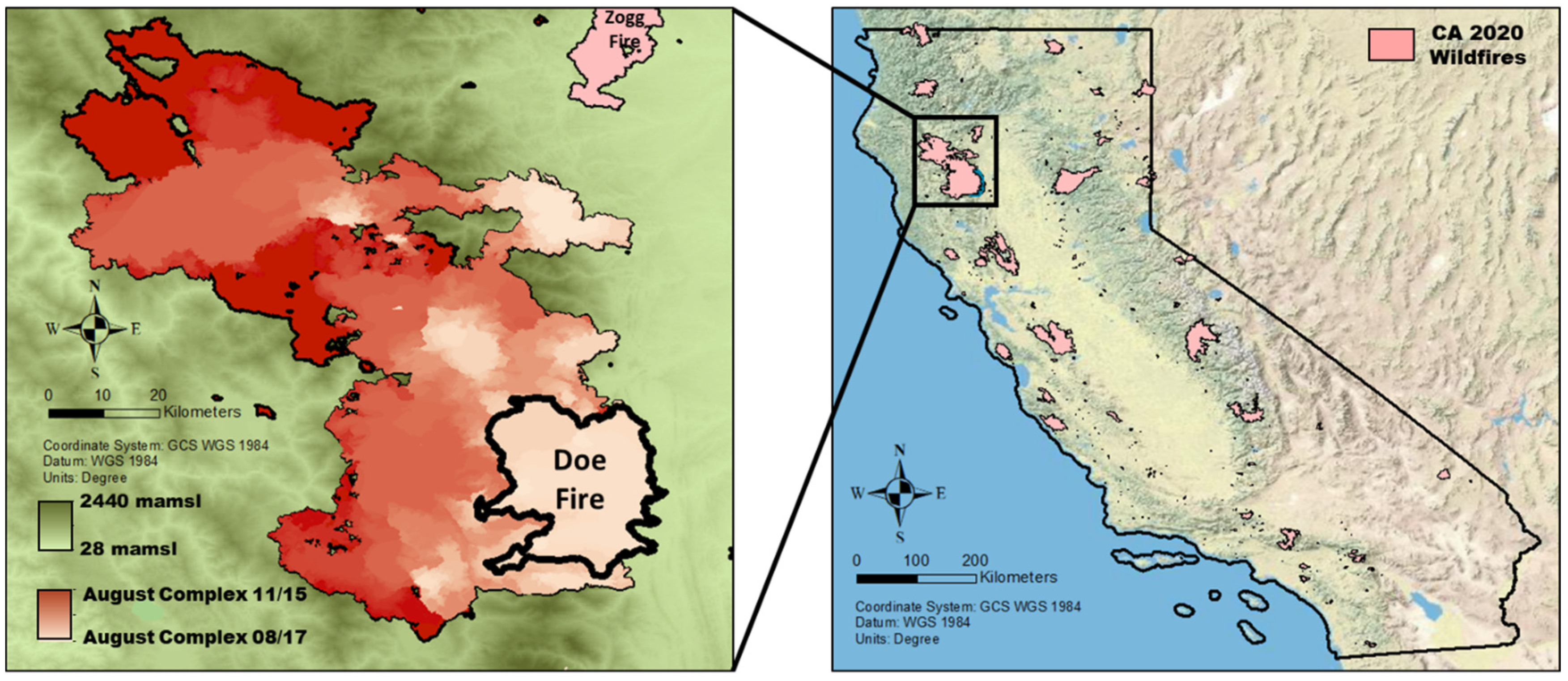


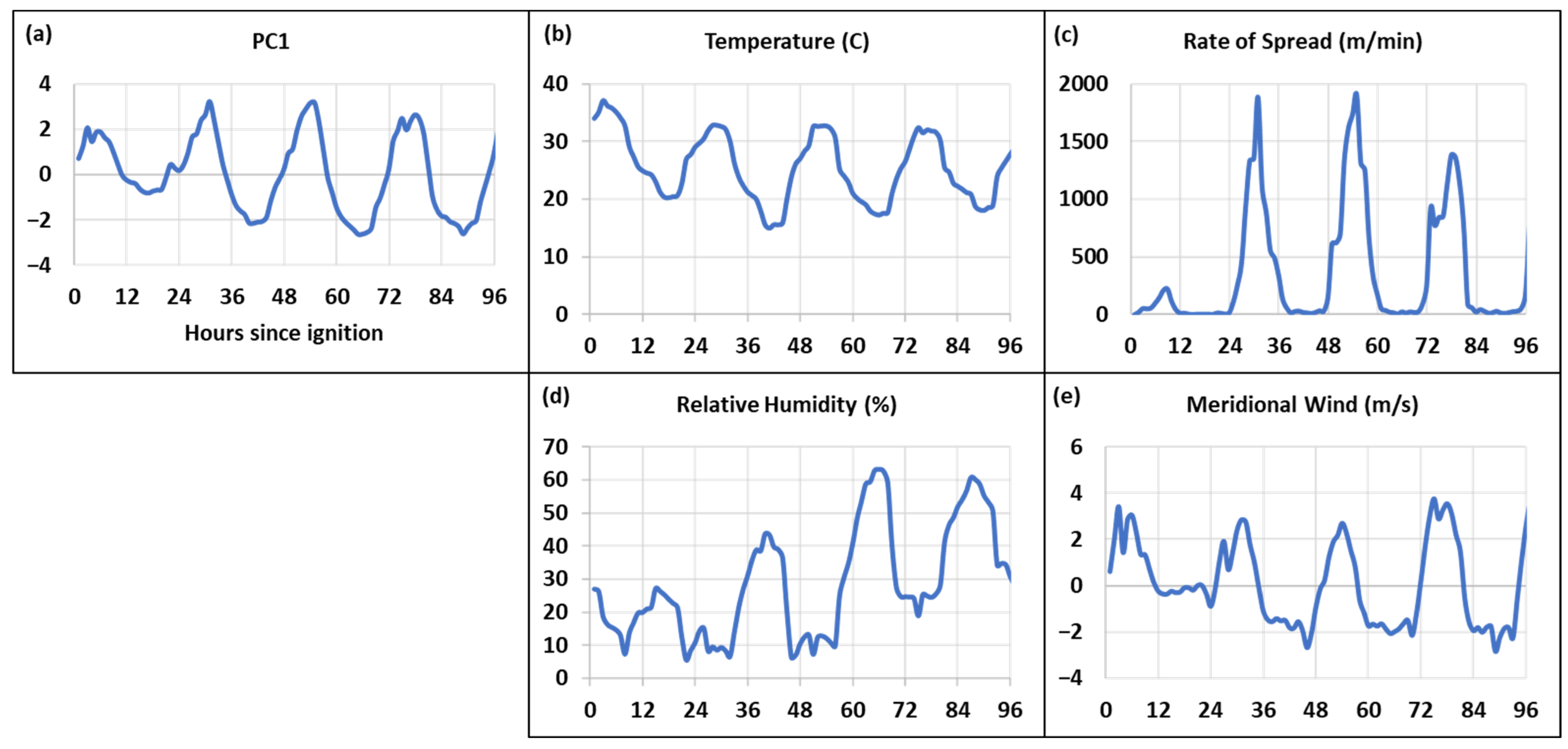
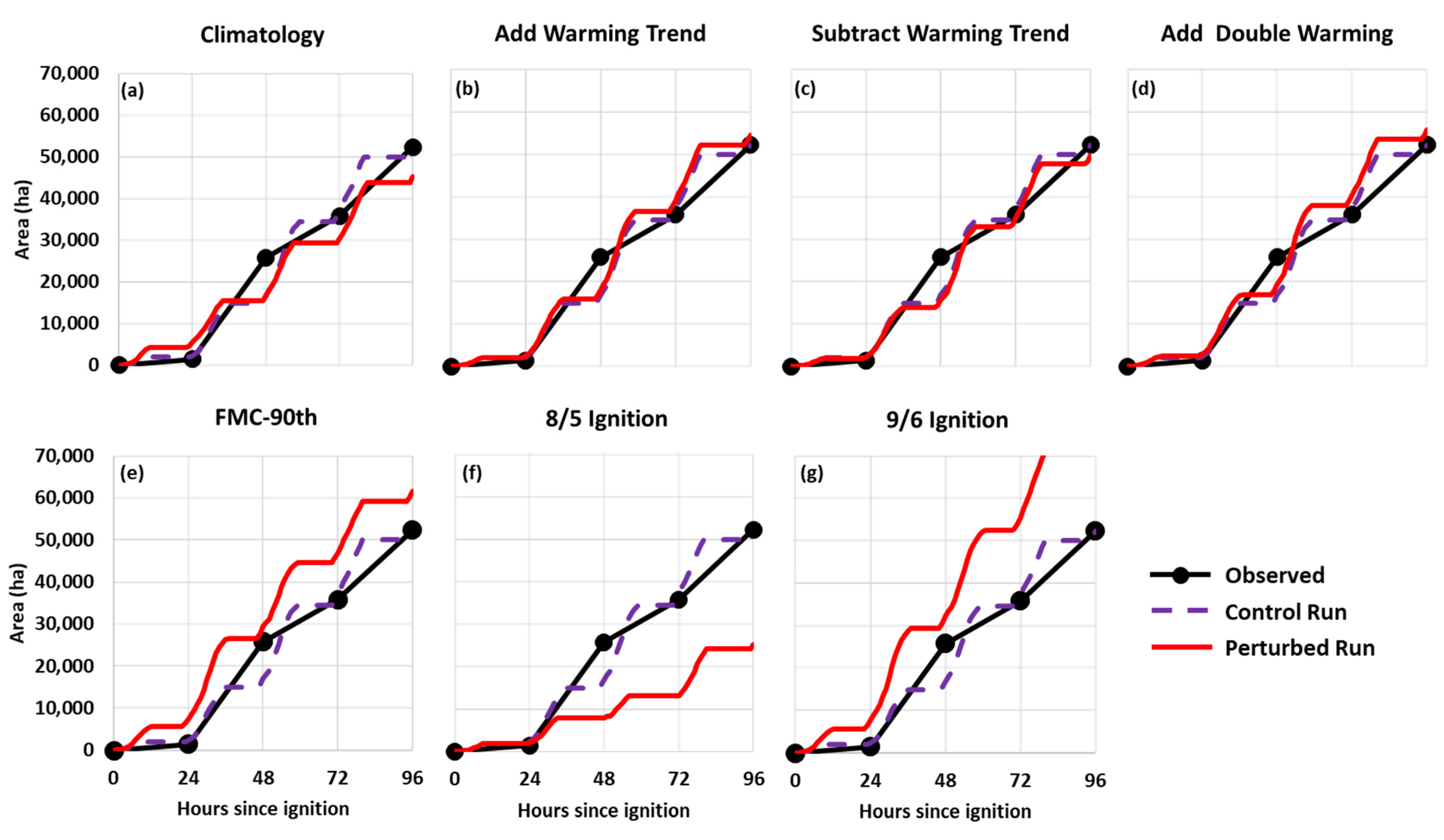

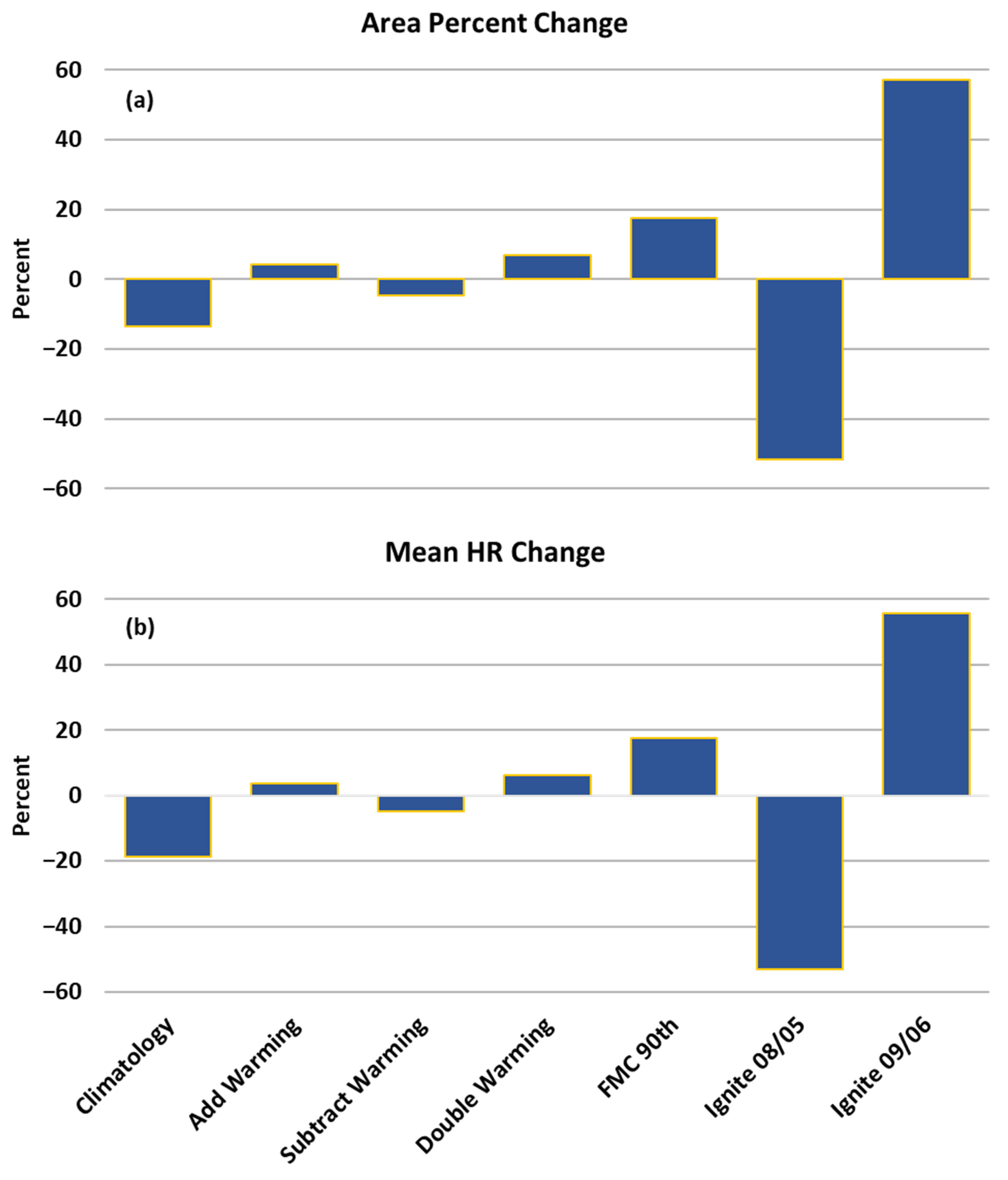

| Required Burning Conditions | Default Value | Calibrated Value |
|---|---|---|
| Initial Spread Index | >6 | >6 |
| Fire Weather Index | >20 | >20 |
| Wind Speed (km/h) | >4 | >1.2 |
| Relative Humidity (%) | <25 | <40 |
| Variance Explained | Correlations | ||||||
|---|---|---|---|---|---|---|---|
| Eigenvalue | % Variance | Variables | PC1 | PC2 | PC3 | PC4 | PC5 |
| 2.94 | 58.77 | T | 0.92 | 0.04 | −0.21 | 0.20 | −0.25 |
| 1.07 | 21.37 | RH | −0.80 | −0.32 | 0.34 | 0.37 | −0.08 |
| 0.54 | 10.88 | U | −0.10 | 0.96 | 0.24 | 0.08 | −0.02 |
| 0.32 | 6.45 | V | 0.92 | −0.04 | 0.06 | 0.31 | 0.23 |
| 0.13 | 2.51 | ROS | 0.77 | −0.20 | 0.57 | −0.21 | −0.06 |
| T (°C) | RH (%) | VPD (hPa) | WS (km/h) | FFMC | DMC | DC | FWI | ROS (m/min) | HR (MW) | Growth (ha) | |
|---|---|---|---|---|---|---|---|---|---|---|---|
| Day 1 | 32.9 | 17.1 | 42.2 | 6.1 | 92.6 | 456 | 590 | 36.3 | 4.51 | 1118 | 1932 |
| Day 2 | 29.5 | 12.9 | 37.0 | 9.0 | 94.2 | 462 | 598 | 46.0 | 6.63 | 1222 | 11,172 |
| Day 3 | 29.4 | 16.3 | 35.5 | 2.0 | 94.7 | 467 | 607 | 38.0 | 5.72 | 1249 | 16,675 |
| Day 4 | 29.3 | 30.1 | 29.5 | 3.3 | 94.2 | 472 | 615 | 38.0 | 4.66 | 989 | 12,917 |
| Experiments | T (°C) | RH (%) | VPD | FFMC | DMC | DC | FWI | # Spreading Hours |
|---|---|---|---|---|---|---|---|---|
| Control | 25.3 | 28.5 | 25.7 | 90.1 | 465 | 603 | 29.3 | 48 |
| Climatology | 23.2 | 34.5 | 20.4 | 89.5 | 407 | 492 | 26.7 | 43 |
| Add 0.8 | 26.1 | 28.5 | 26.9 | 90.2 | 467 | 606 | 29.7 | 49 |
| Add 1.6 | 26.9 | 28.5 | 28.2 | 90.4 | 470 | 609 | 30.1 | 50 |
| Subtract 0.8 | 24.5 | 28.5 | 24.5 | 89.9 | 462 | 600 | 28.9 | 48 |
| FMC 90th | 25.3 | 28.5 | 25.7 | 90.8 | 514 | 504 | 31.3 | 52 |
| 5-August | 24.7 | 37.7 | 21.4 | 88.3 | 398 | 490 | 25.0 | 36 |
| 6-September | 25.9 | 16.6 | 30.0 | 91.8 | 557 | 756 | 34.2 | 61 |
Publisher’s Note: MDPI stays neutral with regard to jurisdictional claims in published maps and institutional affiliations. |
© 2022 by the authors. Licensee MDPI, Basel, Switzerland. This article is an open access article distributed under the terms and conditions of the Creative Commons Attribution (CC BY) license (https://creativecommons.org/licenses/by/4.0/).
Share and Cite
Varga, K.; Jones, C.; Trugman, A.; Carvalho, L.M.V.; McLoughlin, N.; Seto, D.; Thompson, C.; Daum, K. Megafires in a Warming World: What Wildfire Risk Factors Led to California’s Largest Recorded Wildfire. Fire 2022, 5, 16. https://doi.org/10.3390/fire5010016
Varga K, Jones C, Trugman A, Carvalho LMV, McLoughlin N, Seto D, Thompson C, Daum K. Megafires in a Warming World: What Wildfire Risk Factors Led to California’s Largest Recorded Wildfire. Fire. 2022; 5(1):16. https://doi.org/10.3390/fire5010016
Chicago/Turabian StyleVarga, Kevin, Charles Jones, Anna Trugman, Leila M. V. Carvalho, Neal McLoughlin, Daisuke Seto, Callum Thompson, and Kristofer Daum. 2022. "Megafires in a Warming World: What Wildfire Risk Factors Led to California’s Largest Recorded Wildfire" Fire 5, no. 1: 16. https://doi.org/10.3390/fire5010016
APA StyleVarga, K., Jones, C., Trugman, A., Carvalho, L. M. V., McLoughlin, N., Seto, D., Thompson, C., & Daum, K. (2022). Megafires in a Warming World: What Wildfire Risk Factors Led to California’s Largest Recorded Wildfire. Fire, 5(1), 16. https://doi.org/10.3390/fire5010016







